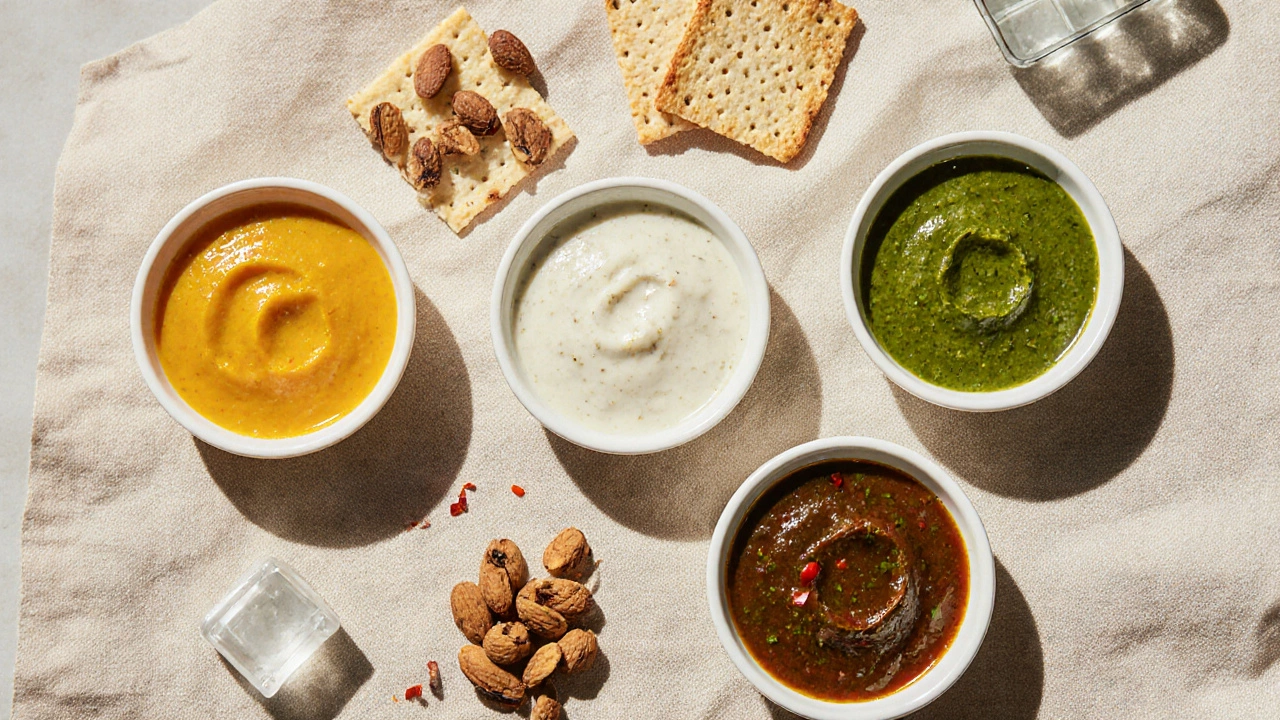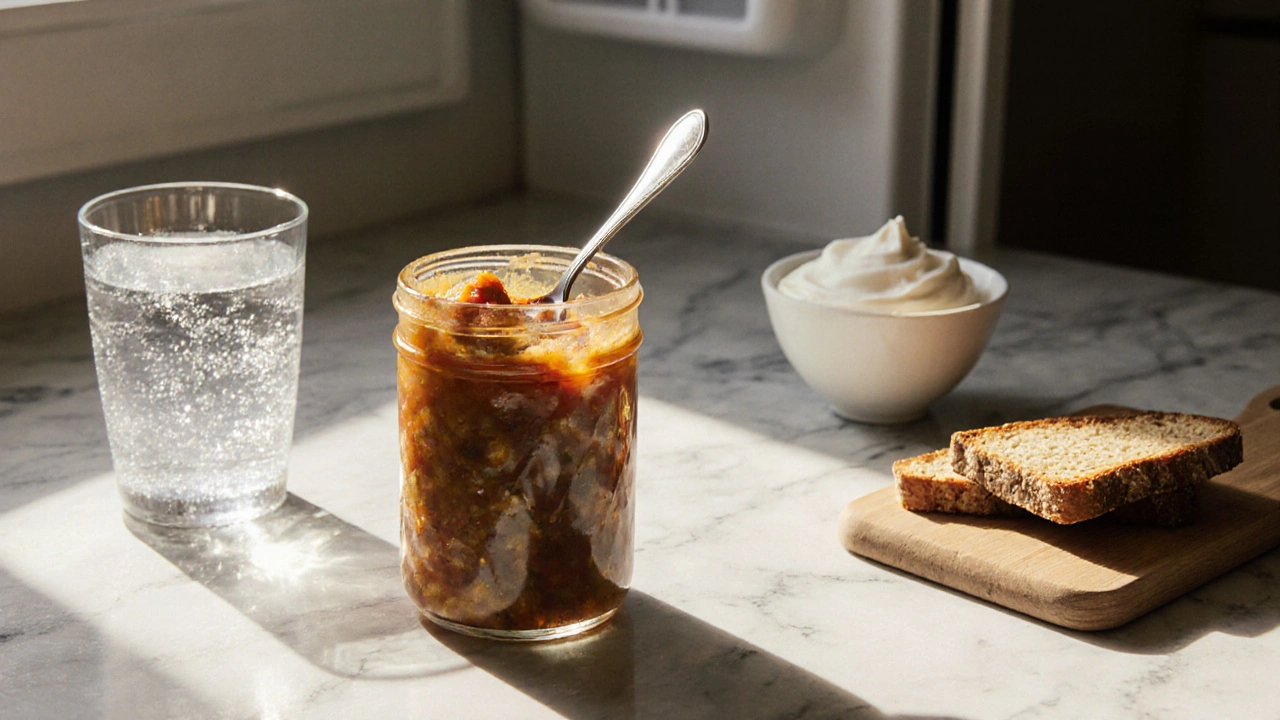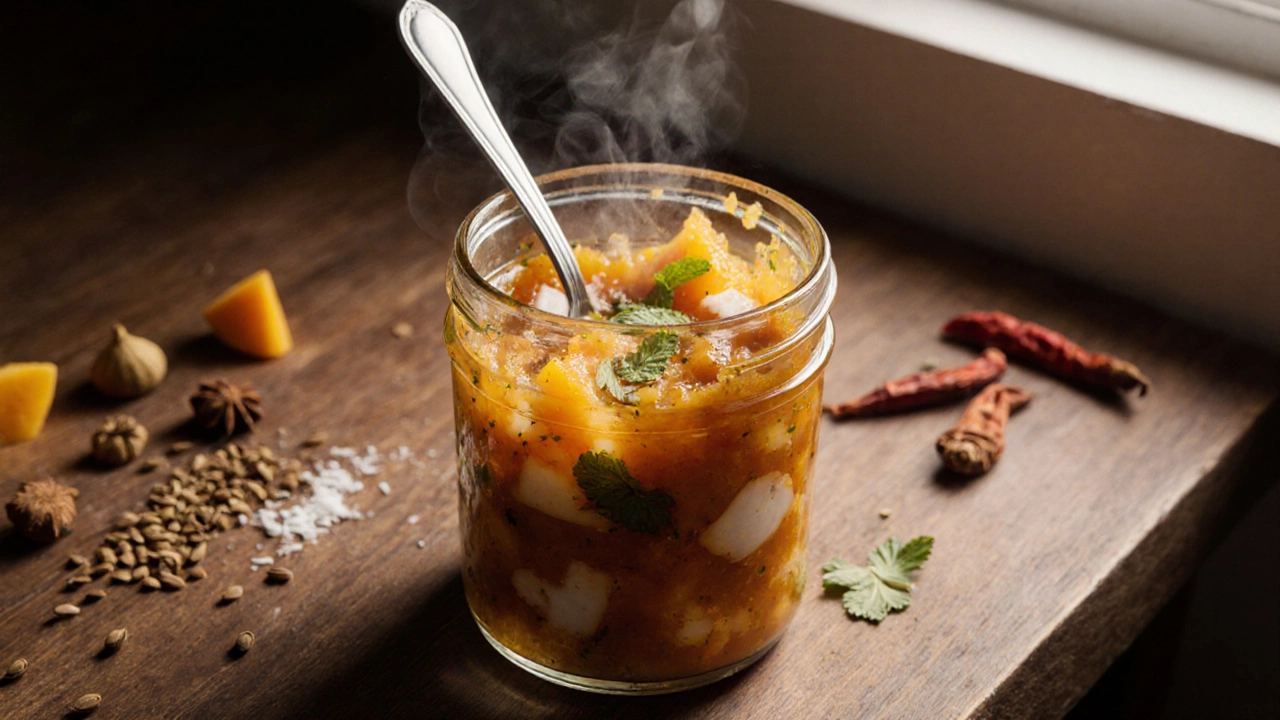Chutney Solo Eating Guide
Calories: 30-45
Carbs: 7-10 g
Protein: 0 g
Vitamins: Vitamin A, C
Natural sugars satisfy snack cravings.
Best ways to enjoy chutney alone:
- Spread on crackers or rice cakes
- Mix with plain Greek yogurt
- Drizzle over toasted nuts
- Layer on whole-grain bread
- Freeze in ice-cube trays
Chutney Consumption Tip
Start with a small portion and adjust according to your taste preference.
Quick Takeaways
- Most chutneys are safe to eat straight from the jar, but flavor intensity varies.
- Sweet chutneys (mango, coconut) work best as a solo snack, while spicy ones shine with a bite.
- Portion control matters - a tablespoon gives a flavor burst without overwhelming calories.
- Store chutney in the fridge; most last 2‑3 weeks, some ferment longer.
- Pairing suggestions for solo eating include crackers, roasted nuts, or plain bread.
When it comes to Indian flavor boosters, chutney is a condiment made from fruits, vegetables, herbs, spices, and sometimes nuts, blended into a thick sauce. The question “Can you eat chutney by itself?” pops up a lot, especially for people trying to keep snack time simple or exploring Indian cuisine without the full meal. Below we break down the safety, taste, health angles, and the best ways to enjoy chutney alone without any side dishes.
What Exactly Is Chutney?
Chutney isn’t a single thing; it’s a family of sauces that originated in Indian cuisine. Traditional versions can be wet (like a fresh herb paste) or dry (like a ground spice mix). Common bases include mango, coconut, mint, coriander, and tamarind. Each base brings a different balance of sweet, sour, and spicy flavors.
Is Eating Chutney Straight From the Jar Safe?
From a food‑safety perspective, most commercially‑packaged and home‑made chutneys are fine to eat as‑is, provided they’ve been stored correctly. Here’s a quick safety checklist:
- Check the expiration date or “best‑by” stamp on store‑bought jars.
- If the chutney smells off, shows mold, or has an odd texture, discard it.
- Home‑made chutney should be refrigerated within two hours of preparation and kept below 4°C (40°F).
- Fermented chutneys (like typical South Indian peanut or dosa chutney) develop probiotic cultures; they’re safe but may get stronger over time.
In short, as long as you follow basic storage rules, there’s no health risk in scooping a spoonful straight out.

Which Chutneys Shine When Eaten Solo?
Flavor intensity is the main factor. Sweet or mildly tangy chutneys are the most enjoyable on their own, while ultra‑spicy or extremely sour varieties can feel overwhelming without a neutral companion.
| Chutney | Base Flavor | Ideal Solo Portion | Why It Works Solo |
|---|---|---|---|
| Mango Chutney | Sweet‑tart | 1‑2 Tbsp | Natural sugars satisfy snack cravings. |
| Coconut Chutney | Nutty‑mild | 1 Tbsp | Creamy texture feels like a dip. |
| Mint‑Coriander Chutney | Herby‑fresh | ½‑1 Tbsp | Cleaning palate without heaviness. |
| Tamarind Chutney | Sour‑sweet | ½ Tbsp | Sharp bite works as a flavor punch. |
| Spicy Peanut Chutney | Nutty‑hot | ⅓ Tbsp | Heat is balanced by peanuts; small amount suffices. |
Notice the portion column - a little goes a long way. Too much of a hot chutney can cause tongue‑burn, while a generous spoon of mango chutney can feel like dessert.
How to Turn Chutney Into a Stand‑Alone Snack
Even if you eat it solo, you might want a little texture. Here are five no‑fuss ideas:
- Spread on crackers or rice cakes. The crunch adds contrast without drowning the flavor.
- Mix with plain Greek yogurt (½cup yogurt + 1Tbsp chutney). You get a creamy dip that’s still mostly chutney.
- Drizzle over toasted nuts (almonds, cashews). The nuts soak up the sauce and become bite‑size flavor bombs.
- Layer on a slice of whole‑grain bread and toast for 1‑2minutes. Warmth mellows sharp edges.
- Freeze small cubes (using an ice‑cube tray) for a chilled, bite‑size treat on hot days.
All these tweaks keep the core idea of “eating chutney by itself” while adding a pleasant mouthfeel.
Nutrition Snapshot: Is Chutney a Healthy Snack?
Most chutneys pack a nutritional punch, but the profile depends on the base and added sugars.
| Chutney Type | Calories | Carbs | Protein | Key Vitamins |
|---|---|---|---|---|
| Mango | 30‑45 | 7‑10g | 0g | VitaminA,C |
| Coconut | 20‑35 | 2‑4g | 1g | VitaminE,K |
| Mint‑Coriander | 15‑25 | 2‑3g | 0g | VitaminK,Folates |
| Tamarind | 25‑40 | 6‑9g | 0g | VitaminB1,C |
| Peanut (spicy) | 45‑60 | 3‑5g | 2‑3g | VitaminE,Niacin |
Watch for added sugar in commercial jars - some brands can push carbs up to 12g per tablespoon. If you’re counting calories, stick to fruit‑based chutneys with minimal sweeteners.

Storage Tips to Keep Your Chutney Fresh
- Transfer to a clean, airtight glass jar after opening.
- Always use a clean spoon; contamination shortens shelf life.
- Refrigerate immediately; most chutneys stay good for 2-3weeks.
- For fermented versions, you can keep them up to 2months - the flavor deepens over time.
- If a chutney develops a sour smell that isn’t typical for the variety, discard it.
These habits ensure you can grab a spoonful any day without worrying about spoilage.
Common Pitfalls and How to Avoid Them
- Too much heat. If you’re sensitive to spice, start with ½Tbsp of a hot chutney and add more as you get comfortable.
- Over‑sweetening. Commercial mango chutney often contains extra sugar. Look for “no added sugar” labels or make your own.
- Dry texture. Some chutneys thicken after refrigeration. Stir in a splash of water, lemon juice, or a bit of yogurt to loosen them.
- Portion overload. A tablespoon of peanut chutney can be 60calories - easy to over‑eat if you’re not watching portions.
Mini FAQ
Can I eat raw coconut chutney without cooking?
Yes. Fresh coconut chutney is usually made with raw coconut, green chilies, and spices, then blended with water. It’s safe to eat straight away, though a quick 5‑minute steam can mellow the raw flavor if you prefer.
Is spicy peanut chutney too hot to eat alone?
It can be intense. Start with a teaspoon and see how your palate reacts. Adding a dash of yogurt or a few plain crackers can tone down the heat while keeping the snack simple.
Do fermented chutneys have probiotic benefits?
Yes. Fermented chutneys develop live cultures that support gut health, similar to yogurt or kefir. Just ensure they’re stored in the fridge and consumed before the taste becomes overly sour.
How long can I keep homemade mango chutney?
If sealed in a sterilized jar and refrigerated, about 3weeks. For longer storage, process the jars in a boiling‑water bath for 10minutes; the chutney can then last 6months unopened.
Can I freeze chutney for later use?
Absolutely. Freeze in airtight containers or ice‑cube trays. Thaw in the fridge and stir well before serving. Texture may become slightly thinner, but the flavor stays intact.
Next Steps
If you’ve never tried a chutney solo, start with a sweet mango or creamy coconut version. Grab a small spoon, enjoy the burst, and note how it feels. Once comfortable, experiment with spicy or fermented types, adjusting portion size as needed. Keep the storage tips in mind, and you’ll have a versatile, ready‑to‑eat snack for any time of day.
